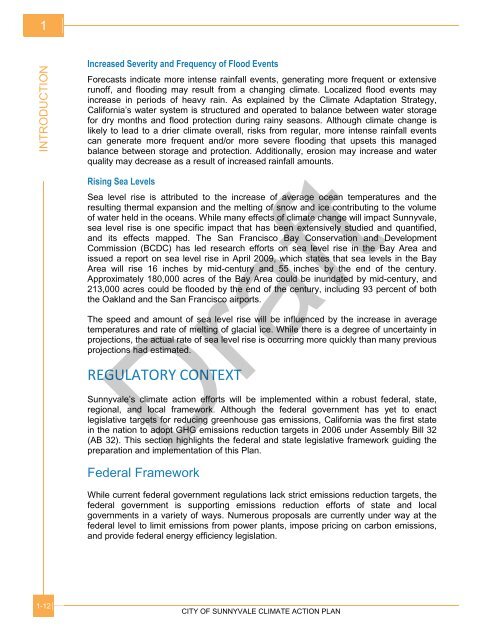DRAFT Climate Action Plan - PMC
DRAFT Climate Action Plan - PMC
DRAFT Climate Action Plan - PMC
Create successful ePaper yourself
Turn your PDF publications into a flip-book with our unique Google optimized e-Paper software.
1<br />
INTRODUCTION<br />
Increased Severity and Frequency of Flood Events<br />
Forecasts indicate more intense rainfall events, generating more frequent or extensive<br />
runoff, and flooding may result from a changing climate. Localized flood events may<br />
increase in periods of heavy rain. As explained by the <strong>Climate</strong> Adaptation Strategy,<br />
California’s water system is structured and operated to balance between water storage<br />
for dry months and flood protection during rainy seasons. Although climate change is<br />
likely to lead to a drier climate overall, risks from regular, more intense rainfall events<br />
can generate more frequent and/or more severe flooding that upsets this managed<br />
balance between storage and protection. Additionally, erosion may increase and water<br />
quality may decrease as a result of increased rainfall amounts.<br />
Rising Sea Levels<br />
Sea level rise is attributed to the increase of average ocean temperatures and the<br />
resulting thermal expansion and the melting of snow and ice contributing to the volume<br />
of water held in the oceans. While many effects of climate change will impact Sunnyvale,<br />
sea level rise is one specific impact that has been extensively studied and quantified,<br />
and its effects mapped. The San Francisco Bay Conservation and Development<br />
Commission (BCDC) has led research efforts on sea level rise in the Bay Area and<br />
issued a report on sea level rise in April 2009, which states that sea levels in the Bay<br />
Area will rise 16 inches by mid-century and 55 inches by the end of the century.<br />
Approximately 180,000 acres of the Bay Area could be inundated by mid-century, and<br />
213,000 acres could be flooded by the end of the century, including 93 percent of both<br />
the Oakland and the San Francisco airports.<br />
The speed and amount of sea level rise will be influenced by the increase in average<br />
temperatures and rate of melting of glacial ice. While there is a degree of uncertainty in<br />
projections, the actual rate of sea level rise is occurring more quickly than many previous<br />
projections had estimated.<br />
REGULATORY CONTEXT<br />
Sunnyvale’s climate action efforts will be implemented within a robust federal, state,<br />
regional, and local framework. Although the federal government has yet to enact<br />
legislative targets for reducing greenhouse gas emissions, California was the first state<br />
in the nation to adopt GHG emissions reduction targets in 2006 under Assembly Bill 32<br />
(AB 32). This section highlights the federal and state legislative framework guiding the<br />
preparation and implementation of this <strong>Plan</strong>.<br />
Federal Framework<br />
Draft<br />
While current federal government regulations lack strict emissions reduction targets, the<br />
federal government is supporting emissions reduction efforts of state and local<br />
governments in a variety of ways. Numerous proposals are currently under way at the<br />
federal level to limit emissions from power plants, impose pricing on carbon emissions,<br />
and provide federal energy efficiency legislation.<br />
1-12<br />
CITY OF SUNNYVALE CLIMATE ACTION PLAN


